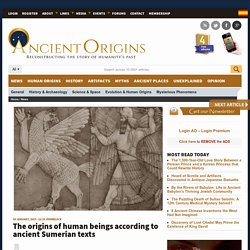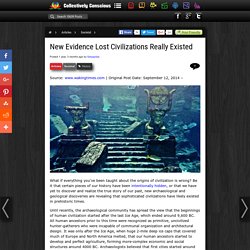

Saturday, May 24, 2008. Geologic Time Clock. Huge Underwater Pyramid Discovered Near Portugal – The Navy is Investigating. Portuguese news reported the discovery of a very large under water pyramid first discovered by Diocleciano Silva between the islands of São Miguel and Terceira in the Azores of Portugal.

According to claims, the structure is said to be perfectly squared and oriented by the cardinal points. Current estimates obtained using GPS digital technology put the height at 60 meters with a base of 8000 square meters. Cosmic Inflation Explained. Free excerpt from The PHD Movie 2!

- Watch this free clip from the movie that Nature called "Astute, funny"! Study confirms that Neanderthals and humans got it on. The genetic similarities between certain human populations and Neanderthals are striking.

Indeed, many researchers think the Europeans and Asians inherited between 1 and 4 percent of their DNA from Neanderthals, yet scientists have struggled to demonstrate with a high degree of certainty that these genetic similarities are the result of interbreeding between these two species. Now, a pair of European scientists say that they have confirmed the human-Neanderthal reproduction hypothesis using statistical modeling — and these results, the researchers add, should go a long way to change the way we think of other human-like species. In the past, genetic similarities between Neanderthals and humans have been associated with two possible scenarios. "A model that involves interbreeding is much more likely. " DNA Analysis of Paracas Elongated Skulls Released: Unknown To Any Human, Primate, or Animal.
Paracas is located in the Pisco Province in the Inca Region on the Southern coast of Peru.

Home of the ground breaking discovery in 1928 by Julio Tello of a massive graveyard containing tombs filled with the remains of individuals with elongated skulls, now known as the famous Paracas Skulls. They are approximately 3000 years old, and initial DNA analysis of them has revealed that they may not have come from humans, but from a completely new species, according to Paracas Museum assistant director, researcher and author Brien Foerster. Here is the apparent quote from the geneticist who did the testing “Whatever the sample labeled 3A has came from – it had mtDNA with mutations unknown in any human, primate or animal known so far. The data are very sketchy though and a LOT of sequencing still needs to be done to recover the complete mtDNA sequence. First Americans. The first face of the first Americans belongs to an unlucky teenage girl who fell to her death in a Yucatán cave some 12,000 to 13,000 years ago.

Her bad luck is science’s good fortune. The story of her discovery begins in 2007, when a team of Mexican divers led by Alberto Nava made a startling find: an immense submerged cavern they named Hoyo Negro, the “black hole.” At the bottom of the abyss their lights revealed a bed of prehistoric bones, including at least one nearly complete human skeleton. Genetic history of indigenous peoples of the Americas. An autosomal genetic tree showing some neighbour-joining relationships within Amerindian peoples Genetic history of indigenous peoples of the Americas primarily focus on Human Y-chromosome DNA haplogroups and Human mitochondrial DNA haplogroups.[1] Autosomal "atDNA" markers are also used, but differ from mtDNA or Y-DNA in that they overlap significantly.[2] The genetic pattern indicates Indigenous Amerindians experienced two very distinctive genetic episodes; first with the initial peopling of the Americas, and secondly with European colonization of the Americas.[3][4] The former is the determinant factor for the number of gene lineages, zygosity mutations and founding haplotypes present in today's Indigenous Amerindian populations.[3] On October 3, 2014, the Oregon cave, where the oldest DNA evidence of human habitation in North America was found, was added to the National Register of Historic Places.

Background[edit] Y-DNA[edit] Haplogroup Q[edit] Haplogroup R1[edit] Haplogroup C-P39[edit] The origins of human beings according to ancient Sumerian texts. Sumer, or the ‘land of civilized kings’, flourished in Mesopotamia, now modern-day Iraq, around 4500 BC.

Sumerians created an advanced civilization with its own system of elaborate language and writing, architecture and arts, astronomy and mathematics. Their religious system was a complex one comprised of hundreds of gods. According to the ancient texts, each Sumerian city was guarded by its own god; and while humans and gods used to live together, the humans were servants to the gods. The Sumerian creation myth can be found on a tablet in Nippur, an ancient Mesopotamian city founded in approximately 5000 BC. Fossil human traces line to modern Asians. 22 January 2013Last updated at 02:45 ET The person shared a common origin with the ancestors of modern Asians Researchers have been able to trace a line between some of the earliest modern humans to settle in China and people living in the region today.

The evidence comes from DNA extracted from a 40,000-year-old leg bone found in a cave near Beijing. New Evidence Lost Civilizations Really Existed. Source: www.wakingtimes.com | Original Post Date: September 12, 2014 – What if everything you’ve been taught about the origins of civilization is wrong?

Be it that certain pieces of our history have been intentionally hidden, or that we have yet to discover and realize the true story of our past, new archaeological and geological discoveries are revealing that sophisticated civilizations have likely existed in prehistoric times. Did An Ancient Mega-tsunami Crash Into Madagascar? Sometime in the last 10,000 years, a gigantic space rock plummeted into the Indian Ocean, creating a mega-tsunami of massive proportions.

Colossal waves enveloped the coast of Africa and left what we see today as chevrons, or wedge-shaped sediment deposits, in Madagascar. But did this actually happen? One might think that geological breadcrumbs are easy to spot, but it’s quite the contrary: As ancient mega-tsunamis wash away, researchers are left looking for signs that they were ever there, or to the contrary, that they were never there to begin with.
Ancient humans. Oldest Human DNA Reveals Mysterious Branch of Humanity. The oldest known human DNA found yet reveals human evolution was even more confusing than thought, researchers say. The DNA, which dates back some 400,000 years, may belong to an unknown human ancestor, say scientists. These new findings could shed light on a mysterious extinct branch of humanity known as Denisovans, who were close relatives of Neanderthals, scientists added. 20 History Questions They Refuse To Answer In School. Traditional educational systems basically teach us that the history of man only dates back to about 8,000 years ago while religious texts date mankind to approximately 6,000 years ago.
It is more than obvious that there a massive push to occlude our true history and origins. While you may not agree with some of the questions, please try to view them with an open mind. As you’ll see, the history we have been taught has been manipulated and obscured from us. Ask yourself (or others) the following questions and feel free to comment at the end of the article! A map drawn on a gazelle skin of an unfrozen Antarctica was found in 1929. 1. 17 Out-of-Place Artifacts Said to Suggest High-Tech Prehistoric Civilizations Existed. By Tara MacIsaac , Epoch Times According to the conventional view of history, humans have only walked the Earth in our present form for some 200,000 years. Advanced civilizations appeared several thousand years ago, but much of the mechanical ingenuity we know in modern times began to develop only around the Industrial Revolution a couple hundred years ago.
Oopart (out-of-place artifact) is a term applied to dozens of prehistoric objects found in various places around the world that seem to show a level of technological advancement incongruous with the times in which they were made. Many scientists attempt to explain them using natural phenomena. Others say such explanations ignore the mounting evidence that prehistoric civilizations possessed advanced technological knowledge that was lost throughout the ages only to be redeveloped in modern times. 17. 2,000-Year-Old Batteries? Right: An illustration of a Baghdad battery from museum artifact pictures. 16. 15. Dr. Dr. 13.